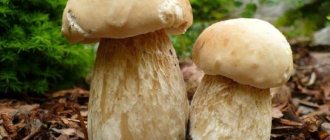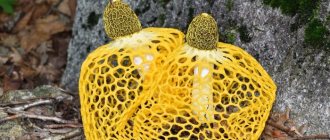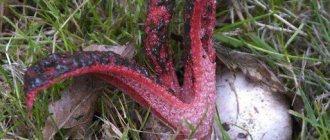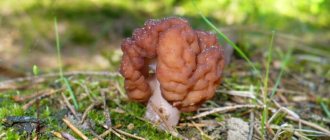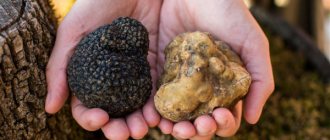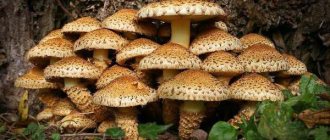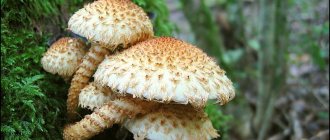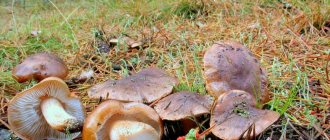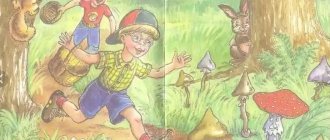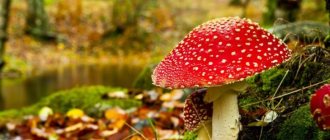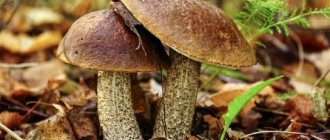It is not for nothing that the satanic mushroom (lat. Boletus satanas) received such a sonorous and ominous name. Its cunning lies in its rare ability to imitate its edible relatives. It is difficult for an experienced mushroom picker to confuse the “devil’s mushroom” with the edible boletus mushroom, popularly known as the “white mushroom”. You can distinguish a lover of mimicry from the “king of mushrooms” by the reddish color of the stem.
Poisonous boletus
Outwardly, this pretender does not at all resemble a poisonous mushroom. Inexperienced mushroom pickers often mistake it for edible prey. The mushroom is large, thick, looks like a boletus, why not put it in a basket? It belongs to the galaxy of red-colored boletuses from the Boletaceae family. These boletus species are little studied. There are a great many of them, in addition to the satanic mushroom. Its equally poisonous boletus relatives:
- felt;
- pink-skinned,
- purple;
- beautiful;
- Frost;
- Burroughs et al.
Felt poisonous boletus mushroom
Pink-skinned poisonous mushroom
Purple poisonous boletus
Beautiful poisonous mushroom
Frost's poisonous mushroom
Burroughs is a poisonous species of boletus
Use in cooking
Common oak mushroom is a conditionally edible mushroom, i.e. one that is suitable for consumption only if properly prepared. They should not be eaten raw or undercooked. You should also not eat old and stale specimens. This will cause stomach upset, vomiting, fever, and can lead to more serious problems.
Important! It is not recommended to use poddubovik together with alcoholic beverages.
If you follow all the cooking rules, you can boil, preserve, fry, and make sauces from it. It is good to include it in recipes for preparing dishes from vegetables, rice, buckwheat, and fried potatoes. Before any cooking method, you must first boil the mushrooms for 15 minutes, drain the water, and then continue processing in the desired way.
Features of the satanic mushroom
A typical representative of the boletus family. His external details:
- Hat. It is massive. Reaches 20-30 cm in diameter. The color of the cap is dull and dim. The shape is pillow-shaped. The cap has damage and roughness. The cap, covered with a velvety dense skin, can be gray, olive, beige, or cream.
- Tubular part . Its thickness does not exceed 2 cm. It has a rich color scheme. The tubes start from yellow, turn to blood red, and then become olive. If damaged, they turn blue.
- Controversy. The color changes from green to olive-brown. Size: 10-16x5-7 microns. They have a fusiform-ellipsoidal shape.
- Leg. Like the hat, it is quite massive. The average length of a mature specimen is 15-17 cm. Width is 10 cm. The shape of the leg is oval, or almost a sphere. There is a specific narrowing in the area of connection with the cap. The color can be very bright - red, beetroot, orange-crimson. A characteristic feature is a mesh pattern.
- Pulp. On the fault the color is yellow, cream, beige. It slowly turns blue at the break. It has a watery structure. The color depends on the living conditions. In specimens grown in the shade, dark and dull shades predominate. Those who grew up in the sun have a brighter and more saturated palette.
In this video, an experienced mushroom picker will show what a satanic boletus looks like and how it differs from an edible porcini mushroom:
Distinctive features of oak wood
Dubovik is an edible representative of forest products with good taste, and in nutritional value is not much inferior to white. It grows mainly in mixed and deciduous forests near oaks, lindens and other trees, and is most abundant from August to October.
The mushroom is quite large in size - its cap can reach 20 cm in diameter; in young fruiting bodies it is convex and half spherical; in adults it straightens out and takes on a pillow-like shape. The color of the cap is variable, yellowish-brown, ocher or brown-gray, and the shades can change into one another even within the same fruiting body. The lower layer is tubular, the color of the tubes is light ocher when young and dirty olive in old fruiting bodies.
The leg of the oak tree is dense, strong, up to 15 cm in height, reaches 3 cm in girth, and in its lower part there is a noticeable thickening. The color of the leg is yellowish closer to the cap and darker below; on its surface you can see a clearly visible dark mesh.
Important! If you cut an oak tree in half, its flesh will quickly turn blue. Because of this, mushrooms of this type are also called “bruises”.
Special signs
This representative of the boletus family, as it ages, acquires a characteristic odor that resembles the stench of carrion or sour foods. But the young ones smell much nicer - their sillage contains pleasant mushroom and spicy notes.
This variety of boletus is characterized by an amazing ability to adapt, mutate and mimic. It can imitate a variety of brothers - edible and conditionally edible. Only because this pretender is rarely found in our forests, poisoning by it is rare.
Can you eat bruise mushrooms?
Bruise is an edible but rare mushroom. Edible but rare mushrooms - bruises, which were once highly valued by our ancestors, grow in all CIS countries. The bruise mushroom is very easy to recognize in forest spaces. A bruise has characteristic differences, among which the ability to acquire a blue tint is considered the most expressive.
Interesting materials:
What is the amount difference? What are light petroleum products? What is Aliexpress Tax Number? What is a mechanical engineering technologist? What is technological ink cleaning? What is thematic planning? What is the timbre of voice and sound? What is sound timbre and what does it depend on? What is heat treatment of foods? What is Tyanochka in youth slang?
Where does it grow?
The mushroom prefers light deciduous forests. Likes to grow in hazel thickets, under hornbeams and beeches, among lindens and chestnuts. Distributed in southern Russia, the Caucasus and the Middle East, and southern Europe. It grows from early summer until October. Favorite soil is limestone.
In Russian forests, fortunately, the satanic boletus is a rare resident. This is confirmed by the absence of numerous names. Frequently occurring species, as a rule, have dozens of names invented by the people. Among the few names of this mushroom is satanic bolete. From Latin “bolet” is translated as “boletus”.
Gall mushroom. Description
Like a real porcini mushroom, bitterling has a stalk that grows to a height of 3-12.5 cm, although its thickness reaches about 1.5-3 cm. The main part of the fruiting body has a cylindrical or club-shaped shape with a swollen, fibrous base . As a rule, the leg at the top is creamy yellow or whitish in color and on its surface there is a pronounced pattern in the form of a blackish or brown mesh. The entire part of the fruit body is filled with whitish pulp and looks massive.
False porcini mushrooms have a number of similarities with their relatives. The bitterlings have a hemispherical cap, which with age acquires more prostrate and rounded cushion-shaped features. The upper part of the fruiting body is finely fibrous, slightly pubescent. During heavy rains, the cap may become more slimy and sticky. Its color varies from yellowish-brown to dark brown and gray-ocher.
Gorchak in section
The main feature of the false porcini mushroom, which makes it easy to identify, is the darkening of the flesh when cut. Thus, the inner layer of the mushroom acquires a reddish tint, has a faint odor and a bitter taste. Due to the fact that the pulp is not wormy, it looks quite presentable and often confuses novice mushroom pickers. The whitish tubes, which in the future become pink or dirty pink, grow to the stem. The pores have an angular and rounded shape; when pressed they become reddish or brown.
In gall fungus, the spore powder may be pink-brown or pinkish. The spores themselves are smooth to the touch and grow in the form of ellipses.
How to distinguish from edible oak trees?
Experienced mushroom pickers will never confuse the forest devil with a real edible boletus, but easily with its variety - the olive-brown oak boletus.
Differences by which you can distinguish two similar mushrooms. In the olive-brown oak tree:
- Hat . Velvety. Color – dark olive or yellowish-brown.
- Pulp. Lemon color. At the break it immediately turns blue, and not gradually, like the satanic boletus.
Oakberry is edible, but consumed raw can cause dyspepsia. And in combination with alcohol it becomes poisonous.
The mushroom is sick. White and colored boletes - an empire in the world of mushrooms
As I promised in the previous short post, I am posting an article about boletovs.
My subscribers are probably already accustomed to the fact that I do not abuse scientific terms and names that are incomprehensible to the average mushroom picker. In this article I will also try to tell in simple words what kind of animals these are - boletids.
Let's start with the fact that all boletaceae are tubular mushrooms (the reverse side of the cap consists of tubes and looks like a sponge), that is, all boletaceae, boletus mushrooms, boletaceae and other mushrooms are all boletaceae. The only exceptions are tubular polypores, for example liverwort* or SVT*.
But in the class of boletaceae there is a genus, namely boletus (lat. Boletus), this name is translated as boletus and all white ones, boletes and oaks, belong to them. A total of about 50 species.
Don't be alarmed, I'm not going to go through all 50 types! Just list some that most often grow here, but out of ignorance do not end up in the mushroom basket.
In order not to bother your head with academic information, just remember that boletes are divided into white and colored, and among the boletes there are no poisonous ones. Not at all! At all!!! Even the satanic mushroom*, which was previously classified as poisonous, is a good conditionally edible mushroom.
So, only white boletes (all types of white) are definitely edible.
Oak white - most often found in Kuban
Now let's figure out why white is white, because the color of the mushroom, as we see, is not even close to white, and all the others are colored (sometimes all the others are called black).
The thing is that the white pulp does not change color when cut and during processing, including during drying. But all the other (colored) boletes turn blue, red or black when cut, and they all turn black when dried.
Bolet imperial
All colored boletes that change color along the way are conditionally edible and require preliminary boiling for 7-10 minutes. This treatment also helps to get rid of the sour taste and unpleasant odor of some boletes.
Bolet Legala
To be fair, it must be said that among boletus mushrooms there are inedible ones (not poisonous!!! Just inedible) due to their bitter taste. These include pepper and gall, but they are so rare that meeting them is more a miracle than a failure.
Pepper is collected by connoisseurs and gourmets, dried, ground and used as a spice instead of pepper.
In all my mushroom life, I have only encountered the bitter one once: due to an oversight, the bitter one ended up in the basket of my companion, who at that time had little understanding of mushrooms, and I only saw his find at home. Unfortunately, then all the mushrooms from his basket had to be thrown away because all the “neighbors” of the gall mushroom in the basket became quinine-bitter
Bile mushroom
Fortunately, bitter bitter is very easy to 100% identify right in the forest; just lick the bottom of the cap of a dubious boletus - the bitterness is felt instantly! Do not be afraid! It's not dangerous, it's just bitter. Spit and that's it!
Speckled oakweed
All colored boletes, especially oak ones, are dried equally with white ones. It is clear that they are not boiled or even washed before drying. What about conditional edibility? - you ask. The fact is that dried mushrooms are still soaked before use, you just need to drain the water after soaking the dry black ones - that’s the whole secret.
Oak tree olive-brown
A conclusion that has been tested by time and by me: all tubular mushrooms can be safely taken into a basket!
Dubovik Kele
All boletes that change color when cut must first be boiled and the broth drained. After this, they are prepared in the same way as all other tubular ones: pickled, salted, fermented, frozen. Only when drying are they treated in the same way as white ones.
Edible or not?
In Russia, mushroom pickers consider the “forest devil” to be unambiguously poisonous and do not take it into the basket. But in Europe they do not disdain them. According to the mushroom classification of the last century, it is conditionally edible. This means that after certain processing it can be eaten.
To neutralize poisons, a ten-hour soaking is necessary. After lying in water for so long, the mushroom pulp becomes tasteless. But if you don’t soak it in cold water, a person will suffer toxic damage:
- liver;
- nervous system;
- spleen.
Trying the raw pulp of the satanic mushroom is strictly prohibited - serious poisoning is possible. To neutralize toxins, you need to boil the mushroom for at least 10 hours.
In a number of Central European countries, extreme gourmets consider the forest devil not only a digestible food, but also “damn” delicious. But it’s better to listen to mycologists - scientists who study the mushroom kingdom. They claim that if this boletus-like mushroom is not fatal, it is extremely poisonous. They are echoed by resuscitation doctors, whose experience is worth listening to.
In the Czech Republic and France, the collection of this dangerous representative of the mushroom kingdom is practiced. But the debate about the toxicity of this mushroom is not over.
Reviews
Vladimir.
When we go to the forest with friends, they give all the oak trees to me, because they are afraid of this mushroom. On the contrary, my wife and I adore them. Before boiling, I soak them in water for 10-15 minutes. I carry out this procedure three times. Then I boil it for 20 minutes, then wash it and boil it again for 15-20 minutes. As a result, it turns brown. It tastes great.
Lena.
I live in the Urals. We see Dubovik quite often. I don’t particularly respect them myself, as they turn very black during cooking. It ruins the appearance of soups and any other dishes I add them to. The taste is excellent, you can’t take that away from oak. When you cut the fruit body, it turns blue. This is a little scary, but it seems to be considered the norm. I have never seen Satanic mushrooms, so I can’t say whether they are similar or not, but judging by the photo they are almost identical.
Signs of poisoning
Eating the satanic mushroom raw ends in severe poisoning. Symptoms:
- confusion;
- constant urge to vomit;
- bloody diarrhea;
- paralysis;
- hepatic colic;
- spasms in the calf muscles;
- Strong headache.
Along with the main symptoms, a poisoned person may also:
- vision impairment;
- pressure drop;
- there is profuse lacrimation;
- blush your face.
WHO concluded that 10 g of raw Boletus satanas pulp is enough to cause a person’s heart to stop or paralysis of the nervous system to occur, leading to respiratory arrest.
The mushroom is little studied, but it is known that it contains muscarine and glycoprotein - they can cause a toxic effect. Mycologists ask mushroom pickers, despite their conditional edibility, not to eat the forest devil. How poisonous a particular specimen is cannot be determined at home. And how eating it will end is also unclear.
Properties and uses of common oak
From fresh fruiting bodies, scientists were able to isolate the antibiotic boletol, a substance that suppresses most pathogens. The beta-glucans contained in these mushrooms are excellent for strengthening the immune system. As a result, podubovik is often used in the treatment of malignant tumors. The amino acids contained in the mushroom improve coordination of movement, memory, and significantly reduce the risk of developing atherosclerosis.
It is known that in ancient times, the common boletus was used to prepare tinctures and balms, which were subsequently used to treat depression, chronic fatigue, overwork and nervous disorders.
How to provide first aid?
If you take a set of simple measures in time, serious consequences from consuming a poisonous satanic mushroom can be avoided:
- Call a doctor. You shouldn’t overcome yourself and go to the hospital. Lie down and wait for the doctors to arrive. Relax and don't get out of bed.
- While the doctors are driving, drink activated charcoal.
- Drink more cold liquids - filtered water and strong tea.
While waiting for medical help, you can rinse your stomach with a soda solution. Take 2 teaspoons of soda per liter of water.
If you follow all first aid measures and receive proper treatment, you will be back on your feet within 24 hours. The degree of poisoning depends on the toxicity of the particular specimen - if a lot of poison enters the body, treatment may take weeks.
Season and habitats
When does the satanic mushroom ripen? When is there a high risk of encountering it in the forests?
For its growth and development, this forest dweller prefers oak groves. Also, I don’t mind settling in deciduous forests. It prefers mainly calcareous soil, however, it does not mind growing in acidic areas. Likes to enter into mycorrhiza with oak, hornbeam, aspen, birch, and beech. The most important thing is that the trees are already old and starting to rot.
Also, mycorrhizae also form with fallen and rotting logs.
It is most widespread in the south of Europe, however, in the central zone of Russia it is also found no less often. Large accumulations of this fungus are found in the Caucasus and the Middle East.
As for seasonality, this mushroom begins to ripen in June and grows until September. When it gets warmer, the mushroom itself begins to grow much slower, after which its growth dies down.
Even more information on Wikipedia.
Practical benefits
The satanic boletus, growing under “favorite” trees, forms a special tissue - a mushroom root. In science it is called mycorrhiza. A certain form of mycorrhiza is capable of entwining the root system of trees, forming a kind of cover. The poisonous boletus, entangling tree roots, penetrates into the internal structures of the wood. The bolet is able to merge with the tree, it develops and grows inside the roots.
Mycorrhiza is of economic importance. Scientists have learned to isolate microbiological inoculants from it. They are used in agriculture to increase productivity. Thanks to mycorrhiza, plants receive maximum nutrients and moisture from the soil.
In our country, the attitude towards the satanic mushroom is unequivocal - it is poisonous, and therefore cannot be collected, much less cultivated. Its use at the microbiology level is limited to laboratories and is not widespread.
0
0
Copy link
Edibility
The first thing that interests novice mushroom pickers who have just encountered a satanic mushroom on their way is its edibility. The fact is that the mushroom has a very interesting appearance, so some exotic lovers would not mind trying it. However, we should assure you that the satanic mushroom is poisonous. It is very dangerous to human health, causing poisoning and even death in large quantities. Therefore, you need to protect yourself as much as possible from consuming such flu as food.
In addition, I would like to note that this flu can cause not only poisoning, but also intestinal spasms, which means that health will be seriously compromised.
Although many sources say that after boiling the mushroom becomes edible. But we do not recommend doing this, but we must say about it.
First aid for mushroom poisoning
So, you understand that you have suffered mushroom poisoning. In this case, you cannot self-medicate; you must consult a doctor. However, before the ambulance arrives or you go to the hospital yourself, it is necessary to take a number of consistent actions to improve the condition of those who have been poisoned.
First, you need to try to induce vomiting. To do this, just lean over the toilet and slowly put two fingers in your mouth, try to press on the root of your tongue. If you do this intensively, you can cause a vomiting reaction, which will allow you to spit out the entire contents of your stomach. This measure is necessary, because if not taken in a timely manner, the body will not have time to absorb a large amount of toxins.
However, if this method does not help you (relief does not come) or you cannot call to your work, then you can resort to the next method.
You need to carefully place the patient on his side. At the same time, give him a large amount of ordinary water. Make him drink water until he starts vomiting. It is very important that the water dissolves toxic substances and carries more of them out through urination or vomiting.
Then, wait for the ambulance to arrive. Afterwards, follow the doctor's recommendations. Most likely, the doctor will ask you to go to the hospital, where the patient will have a gastric lavage, and will also be asked to remain under the influence of IV drips for some time in order to restore the body from the shock received. After all, poisoning is in any case a great stress for the body.
Signs of mushroom poisoning
How to understand that poisoning has occurred? When do poisons begin to act and what to do to prevent symptoms. And most importantly, how to help the body recover?
So, in order to save your body, and most importantly, avoid serious consequences, you must first pay attention to the symptoms. As a rule, they begin to appear an hour after you eat mushrooms.
- You suddenly experience nausea or vomiting. Perhaps this is a weak feeling, or perhaps real urges. However, it is not recommended to keep vomit to yourself; on the contrary, the more you eat, the less damage will be done to the body.
- Dizziness and headaches. Yes, poisoning is very often accompanied by dizziness. Therefore, if you feel that the ground is disappearing from under your feet, but you can’t concentrate well on what’s happening around you, you feel a ringing in your ears or just a pulsating risk, most likely this is also another sign of poisoning.
- You begin to feel hot and cold. Chills very often accompany mushroom poisoning. You either start to sweat and want to undress, or want to wrap yourself in the warmest blanket.
- Weakness. You are unable to be active, stand on your feet, you want to lie down and sleep. However, this should not be done under any circumstances, as you need to control the condition of your body.
- You lose consciousness. You disconnect from what is happening for a while, then come to your senses again. As a rule, this often happens when it comes to poisoning. In order to prevent this phenomenon, it is necessary to call a doctor.
There may be other symptoms that are specific to your body, since everything is individual. For example, many people who were poisoned experienced indigestion and said that they felt severe pain in the stomach area; it arose as a result of the fact that toxic substances began to be absorbed into the wall of the stomach, which caused discomfort.
In any case, listen to your body. If you think that something is going wrong, then, of course, consult a doctor as soon as possible. And even if your poisoning is not confirmed, in this case it is better to foresee everything in advance and try to protect yourself than to wait for events to develop, which may be the most inappropriate.
